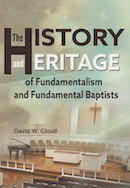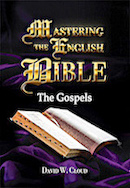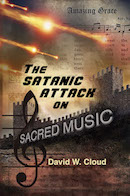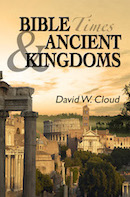866-295-4143, fbns@wayoflife.org
Following is a link to translations of the Dead Sea Scrolls -
http://dssenglishbible.com/psalms%20106.htm
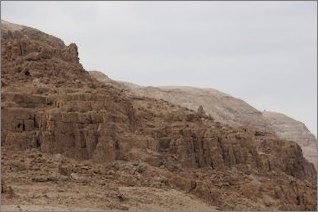
Qumran Caves
The scrolls were discovered between 1947 and 1956 in 11 caves near the northwest shore of the Dead Sea, 13 miles southeast of Jerusalem. The first cave contained two Isaiah scrolls, including the nearly intact Great Isaiah Scroll.
The scrolls were preserved by the exceedingly dry climate of the caves, which are 1,300 feet below sea level.
The scrolls contain the remains of about 900 different writings, mostly written between 200 BC. and AD 68. The vast majority of the scrolls are in fragments. The Dead Sea Scrolls have been called “the world’s greatest jigsaw puzzle.” Most of the scrolls were written on parchment (sheep or goat skins), while a minority were written on papyrus (paper made of the papyrus plant) and clay, and two were written on copper (Geza Vermes, The Story of the Scrolls, 2010).
Four-fifths of the scrolls are written in Hebrew, and 25% of them are books of the Bible. There are parts of every Old Testament book except Esther, thus confirming the traditional canon of Scripture. There are 15 copies of Genesis, 17 of Exodus, 13 of Leviticus, eight of Numbers, 29 of Deuteronomy, two of Joshua, three of Judges, 21 of Isaiah, six of Jeremiah, six of Ezekiel, 36 of Psalms, two of Proverbs, and four of Ruth.
Advanced dating tests in the early 1990s confirmed that the biblical scrolls date to the two centuries before Christ (George Bonani, “Carbon-14 Tests Substantiate Scroll Dates,” Biblical Archaeology Review, November/December 1991, p. 72).
The Great Isaiah Scroll
The most important and complete Old Testament book among the Dead Sea Scrolls is the Great Isaiah Scroll, which contains all 66 chapters of Isaiah. It was found in the first cave and was written on 17 pieces of sheepskin sewn together to form a scroll measuring about 24 feet in length. It resides at the Shrine of the Book at the Israel Museum in Jerusalem, and a realistic facsimile is on display in the main room. It has been dated at least four times by the carbon-14 method and the results have ranged from 335 to 107 BC. Other techniques (e.g., writing material and style, associated coins and other artifacts) have dated it to 150-100 BC. Thus, it was written at least a century before Christ and probably two centuries before.
The Essenes Cult
The non-biblical books of the Dead Sea Scrolls represent a wide range of books, many of which are the heretical teachings of a Jewish cult called the Essenes, which probably operated a monastic community nearby at Qumran. They considered themselves the true Israel and believed that God had called them to restore the Law of Moses and establish the kingdom of God on earth. Their leader was called “the Teacher of Righteousness.”
Believing that the temple worship in Jerusalem was impure, they separated from it and moved to the desert to await the coming of the Messiah, thinking they were fulfilling Isaiah 40:3.
They saw themselves as the “Sons of Light” and the “Sons of Righteousness” and everyone else as “the Sons of Darkness,” and they were expecting the Messiah to return and lead them in defeating the “armies of Belial” in an extended war and then build a new temple and reestablish the pure temple worship. This is described in their books The War Rule and The New Jerusalem.
They expected the new Temple to be operated by their Temple Book, which was a 28-foot scroll purporting to be God’s instruction to Israel for the operation of the temple. They expected an end-time prophet and two Messiahs to lead in the conquering of the Sons of Darkness (the Gentiles and apostate Jews). One was a priestly Messiah of the lineage of Aaron, known as the Interpreter of the Law, and the other was a “lay Messiah,” which they referred to as “the Branch of David” (Vermes, p. 188). This confusion came about from their misunderstanding of the Messianic prophecies. The Branch of David is actually the one and only Messiah, who came in the person of Jesus and was rejected, just as Isaiah 53 prophesied.
The Essenes were ascetic and legalistic in the extreme. They wore their clothes until they fell to pieces and lived on a frugal diet. They wore white robes and took frequent ritual baths. Most were celibate but those who were married had to submit to the community’s rules even in matters of intimacy. If a husband and wife had intimate relations “against the rules,” they were put out of the community. They were fanatical sabbath keepers, not being allowed to assist an animal in labor or pull an animal out of a hole into which it had fallen, and if even a man fell into a pit or the water, no rope or ladder could be used in his rescue. They were secretive, with some of their books written in code, and members were forbidden to communicate the secret teachings to outsiders.
They interpreted the Scripture in an allegorical manner after the fashion of Origen, which destroys its inherent authority, making the mind of the interpreter the authority.
Though a minority of scholars have doubted whether the community at Qumran was associated directly with the scrolls found in the caves nearby, the evidence appears overwhelming. First, it is the most obvious conclusion. Most of the caves are only a stone’s throw from Qumran. Cave 4, which contained two-thirds of the Dead Sea Scrolls, was not merely a quick deposit place but a real library with wooden shelves. Second, the jars in which the scrolls were placed are exactly like ones found at Qumran. Third, evidence of scroll writing was found at Qumran. Fourth, it makes no sense that Jews from Jerusalem would risk carrying the scrolls all the way to Qumran, with the Roman armies spreading out across the countryside, when there were good hiding places nearby. Fifth, many of the scrolls are anti-establishment. They were written by a cult that had been evicted from the temple in Jerusalem and were opposed to the Jewish leaders of that day. Sixth, Qumran fits the location where the Roman philosopher Pliny situated the Essene settlement, on the western shore of the Dead Sea.
The Qumran site has been extensively excavated and is an open-air museum today.
Evidence that Bible Prophecy was Pre-written
For the Bible believer, the greatest significance of the Dead Sea Scrolls is that they prove that the hundreds of Messianic prophecies in the Old Testament were written before the birth of Jesus and thus authenticate their divine origin and His Divinity as the Son of God.
For example, Psalm 22 and Isaiah 53 describe Christ’s suffering in great detail, including His rejection by the Hebrew nation, the injustice of His trial, the piercing of His hands and feet, the gambling of the soldiers for His garment, the actual words that He spoke on the cross, the mocking of the crowd, and His burial in a rich man’s tomb. It is impossible for such things to have been known before Jesus was born except by divine revelation.
Authentication of the Masoretic Hebrew Bible
The Dead Sea Scrolls contain powerful evidence for the authenticity of the Masoretic Hebrew text that was the basis for the great Reformation Bibles such as the German Luther, the King James in English, and the Reina Valera in Spanish. The Masoretic text was preserved by the meticulous labor of Hebrew scribes prior to the invention of printing by moveable type in the 15th century. (The first printed Hebrew Bible appeared in 1488.)
The word “masoret” refers to the faithful transmission of the Bible. The Masoretic scribes actually counted each word of the manuscripts, and if a mistake was made that section had to be destroyed. Sixty to sixty-five percent of the Bible scrolls found at the Dead Sea represent the Masoretic text. This is amazing since the earliest Hebrew codexes of the Masoretic text used by textual scholars in the 16th and 17th centuries (such as the Aleppo) were written more than a thousand years after the Dead Sea Scrolls.
The differences between the conservative Dead Sea scrolls and the Masoretic text are extremely minor, largely pertaining to spelling or grammar, the omission or addition of a word, or the mixing of Hebrew letters. For example in Isaiah 7:14, Immanuel is two words in the Masoretic text and one word in the Great Isaiah Scroll, but it is the same name.
The Great Isaiah Scroll’s (1QIsaa, meaning Cave 1 Isaiah a] agreement with the Masoretic text, is called “striking” by Dr. Ernst Wurthwein and “extraordinarily close” by Adolfo Roitman (Wurthwein, The Text of the Old Testament, 1979, p. 144; Roitman, The Bible in the Shrine of the Book, 2006, p. 43).
But the Great Isaiah Scroll is not the best witness to the preserved Scripture. “1QIsaa was poorly copied, as seen in its many corrections, as well as its numerous departures from the MT. It was not done by the most competent scribe (or possibly two scribes).” “The copyist of 1QIsaa produced a carelessly and irregularly written copy that was full of errors," E. Tov. (http://www.emanueltov.info/docs/papers/05.isaiah.2008.pdf?v=1.0). The Great Isaiah Scroll culminated in an, "average of one scribal intervention to every four lines of text” (Ibid.) “That is, the corrector had something to correct every four lines, for 21 feet of scroll! The corrections even seem sloppy. So, it is remarkable that it does align so much with the MT, being so poorly copied. While this does not reduce the value of the scroll as evidence of the contents of Isaiah written down long before their fulfillment or of the firm preservation of the overall message of Isaiah, it affirms that the scroll's deviations from the MT are due to its inferior value as a testimony of the text of Scripture pertaining to details” (Jonathan Cloud, Feb. 11, 2023).
1QIsab (meaning Cave 1 Isaiah b] is a far more important manuscript because it was more faithfully produced and agrees with the Masoretic Text. "The impact of 1QIsab was felt less [than 1QIsaa], especially since it was so similar to MT," wrote Emanuel Tov. (http://www.emanueltov.info/docs/papers/05.isaiah.2008.pdf?v=1.0). “While this does not reduce the value of the [Great Isaiah] scroll as evidence of the contents of Isaiah written down long before their fulfillment or of the firm preservation of the overall message of Isaiah, it affirms that the scroll's deviations from the MT are due to its inferior value as a testimony of the text of Scripture pertaining to details. 1QIsab should, therefore, be the more famous Isaiah Scroll, but due to the bland fact that it gives scholars almost nothing at all to criticize, it sits on the shelf of interest. May the trumpets start sounding, though, and believers come to know what scholars only whisper about” (Jonathan Cloud).
Furthermore, the text of 1QIsab, which supports the Masoretic text, is represented by the fragments of Isaiah from cave 4. “The close relationship between the medieval representative of MT [Masoretic Text], L, and 1QIsab is matched by almost all the texts of Isaiah from cave 4,” E. Tov (http://www.emanueltov.info/docs/papers/05.isaiah.2008.pdf?v=1.0). “That means that the numerous copies (represented by the fragments) found in Cave 4 are all, or nearly all, likewise, either identical or nearly identical to the MT text. That means that even in the worst attestation at Qumran (the Great Isaiah Scroll, which most scholars have gone by), the text is not very different from the MT, though it is possibly the very worst attestation that has gotten the most attention and set the standard in people's minds for the rest” (Jonathan Cloud).
Perhaps the most significant difference between the Dead Sea Scrolls and the Masoretic text is found in Psalm 145. This is an acrostic psalm wherein each verse begins with the next letter of the Hebrew alphabet. In the Masoretic text, verse 13 begins with the 13th letter of the Hebrew alphabet, but verse 14 begins with the 15th letter, and the 14th letter (nun) is missing. Psalm 145 in one of the Dead Sea scrolls (11QPs-a) has the 14th letter beginning this statement: “The LORD is faithful in all his words and kind in all his works.” The words also appear in the Septuagint and the Syriac Peshitta. Some modern English versions, including the Revised Standard Version (RSV), English Revised Version (ERV), New International Version (NIV, 1984), the New Revised Standard (NRSV), and the Holman Standard Version (HSV 2003), add the words at the end of Psalm 145:13, sometimes in brackets. But the fact that the nun line is missing in Psalm 145 does not mean that it was originally present. First, there are acrostics in Psalm 25 and 34 that do not follow the Hebrew alphabet exactly. (For example, in Psalm 25, the bet is missing in verse 2 and the vav in verse 5.) Second, “On the structural side, it is quite common for the acrostic to undergo variation for stylistic reasons. In this case a reason can be offered why the original author chose to remove a letter. With its absence the psalm contains three equal stanzas of seven verses each” (Matthew Winzer, Australian Free Church, Victoria). Third, from a purely human standpoint, it would be strange for a scribe to accidentally delete the nun passage and then for every subsequent scribe to follow such a blunder, if indeed it was the original reading of Psalms. The Masoretic scribes were too careful for such a thing to happen. They would know that a nun line was missing and would only repeat the omission on good textual grounds. It is more likely that it was not a part of the original and that some scribe who was bothered by the omission composed the line to fill the gap. As we will see, the Essenes of Qumran (where the Dead Sea scrolls were found) were not afraid of tampering with the Scripture text. Even critical scholars are not united in favor of following the reading of 11QPs-a in Psalm 145.
Though there are issues such as these, the Bible’s documentary evidence is peerless among ancient books. In contrast, the original reading of books such as the writings of Homer and Plato are impossible to restore with certainty.
For example, it is thought that Homer’s Iliad and Odyssey were composed in the eighth century BC, but the oldest fragments date to at least 500 years later. And the oldest entire manuscripts of Homer’s writings are from the 10th and 11th centuries AD, at least 1,800 years after their writing. There are different editions of the stories, and it is impossible to know what the original said in any detail.
Consider the writings of Confucius, China’s most famous ancient philosopher. The main book containing his teaching is Analects, but it was written by his disciples and took shape over a period of hundreds of years, from about 470 BC to AD 200. The oldest extant portion dates to about 50 BC, which is more than 400 years after Confucius’ death.
There are four reasons why we believe that the non-Masoretic Dead Sea Scrolls should not be used to modify the Masoretic Hebrew text.
First, God promised to preserve His Word. See Psalm 100:5, etc. God put the safekeeping of the Scripture into the hands of the Jews (Romans 3:1-2), and though they didn’t obey the Scripture and though they covered it with their vain rabbinical traditions, they highly revered Scripture and the text they preserved is found in the Masoretic text as represented by the Aleppo Codex.
To think that God preserved His Word by hiding it in a cave for most of church history and causing it to be revealed only at the end of the age in an hour of deep apostasy would mean that the purest text of Scripture was not available to God’s people through most of the church age.
This is contrary to Christ’s teaching in Matthew 28:18-20. He taught that the Scripture is preserved by its use among God’s people. It is preserved in the churches through discipleship.
Scholars now admit that the Masoretic text was the standard Hebrew Bible at the end of the Second Temple period. This has been proven not only by the Dead Sea Scrolls but also by scrolls found at Masada, Wadi Murabba’at, Nahal Hever, and Nahal Tze’elim. Adolfo Roitman says the Masoretic “apparently became the authoritative text for mainstream Judaism toward the end of the Second Temple period” (The Bible and the Shrine of the Book, p. 56).
In light of Romans 3:1-2, that is a major admission! Liberal scholars see the Masoretic text and the Septuagint and Samaritan texts as representing equally legitimate texts. They believe it is only because the rabbis banned the former that the Masoretic text won out. Geza Vermes says,
“[The existence of both Masoretic and Septuagint texts in the Dead Sea Scrolls] suggests that in the Qumran age Hebrew texts corresponding to the Samaritan and the ancient Greek versions jointly circulated, thus buttressing the theory that the proto-Masoretic, Samaritan and Septuagint-type of Hebrew text forms happily co-existed before rabbinic censorship eliminated the last two around 100 CE” (The Story of the Scrolls, p. 106).
This is almost exactly what liberal New Testament scholars believe about the Alexandrian Greek text. They think that the Traditional Greek Text underlying the Protestant Bibles won out only because it was proclaimed official by church councils and pushed by church authorities. The reason they hold this view is that they do not believe that the Old and New Testaments were given by divine inspiration and preserved by the same God who authored them. To them, the Bible is solely a human product, and in studying it they only consider the human element. Like the Sadducees of old, the modernists err by not knowing the power of God (Mark 12:24).
In light of Paul’s statement in Romans 3:1-2 and the many promises in Scripture that God would preserve His Word, we know that God superintended the transmission of the Old Testament, and God led the Jewish rabbis, even in their unbelief and spiritual blindness, to preserve the Masoretic Bible. This Bible was published at the dawn of printing and translated into every major language of the nations during the Reformation era.
Second, it is no more likely that God would preserve the Old Testament by the hands of a weird Jewish cult than that He would preserve the New Testament by the hands of the modern textual criticism cult. The Bible warns God’s people to mark and avoid heretics (Romans 16:17-18). It is therefore unreasonable to think that He would use such heretics to preserve the Scripture.
Three, the “Septuagint-type” text represented by the non-Masoretic Dead Sea scrolls is a loose, paraphrase type translation which should never be used to correct the Hebrew. (Copies of the Septuagint were found at Qumran in Hebrew and in Greek.)
Fourth, there is evidence that the Qumran cult had no fear of tampering with the Scriptures. They “arrogated to themselves the right to creative freedom and considered it their duty to improve the work they were propagating” (Vermes, p. 109). They even invented their own books, such as the Temple Scroll, purporting it to be from God. It would be foolish to modify the Traditional Bible text that has been passed down to us from generation to generation by divine providence on the basis of such flimsy “evidence.”
Another reason for the Bible-believer to be wary about the Dead Sea Scrolls is that the recovery, translation, and analysis were done by skeptical scholars. Of the original editors, four were liberal Catholic priests, one was a Methodist who turned agnostic, and another was an Anglican who converted to Rome. Two were alcoholics. Most liberal Bible scholars consider the cultic writings found in the Dead Sea caves to be on equal authority with the Scriptures. Not believing that the New Testament was given by divine inspiration, these scholars are still looking for the “key capable of opening up the mystery of Jesus and the birth of the Church.” Many think they have found this in the non-Biblical Dead Sea Scrolls.
One of the original editors, John Allegro, claimed in the 1950s that the scrolls contained a description of the crucifixion of a Teacher of Righteousness that he identified with Jesus. Immediately, the other members of the editorial committee issued a statement to the London Times, March 15, 1956, saying, “We find no crucifixion of the ‘teacher,’ no deposition from the cross, and no ‘broken body of their Master’ to be stood guard over until Judgement Day. ... It is our conviction that either he has misread the texts or he has built up a chain of conjectures which the materials do not support.”
In spite of this, Allegro and others have continued to claim that the Teacher of Righteousness described in the scrolls refers either to Jesus or John the Baptist or James, Jesus’ brother.
In 1970, Allegro published a book entitled The Sacred Mushroom and the Cross, nonsensically claiming that Christianity originated with a hallucinogenic mushroom.
Because the editorial committee procrastinated in publishing all of the scrolls, a rumor surfaced that the scrolls contained material damaging to Christianity and that the Vatican had ordered that they be kept secret. The entire material has since been published and there is nothing damaging to the cause of Christ. “... despite the keenest search by the entire scholarly world for hidden explosives, no one came up with anything that might shake the foundations of Christianity, Judaism or any religion” (Vermes, p. 91).
The Dead Sea Scrolls prove that the New Testament was written before AD 68.
Nineteen fragments of the New Testament were found in Cave 7 of the Dead Sea caves at Qumran. These fragments belong to the following Scriptures: Mark 4:28; 6:52-53; 12:17; Acts 27:28; Romans 5:11-12; 1 Timothy 3:16 - 4:3; 2 Peter 1:15. The fragments were irrefutably identified by Dr. Jose O’Callaghan by firsthand examination in 1972. He was an internationally famous papyrologist, one of the very highest experts in the field. O’Callaghan found evidence that Cave 7 held a New Testament library. Dr. O’Callaghan’s research was confirmed in the 1990s by Dr. Carsten Thiede, another expert in the field of papyrology. The fragments date to before 68 AD, which was when the cave was sealed. Bill Cooper observed “]The fragments] stand as immensely trustworthy witnesses to the one single fact that is hated today amongst the critics and unbelievers--that the New Testament was written out, copied and disseminated over parts of the Roman Empire during the forty-year Eyewitness Period (AD 30-70) by people who would have seen and heard our Lord speak, perform miracles, give His life on the cross, and then rise from the dead” (Cooper, The Authenticity of the New Testament Fragments of Qumran).
(See our report “New Testament Fragments of the Dead Sea Caves,” www.wayoflife.org.)
The Shrine of the Book
It is fascinating that the two greatest historical witnesses to the authority of the Masoretic Hebrew Bible are located in one place, the Shrine of the Book in Jerusalem, an arm of the Israel Museum. They are the keepers of both the Great Isaiah Scroll and the Aleppo Codex, the most important ancient complete Masoretic Old Testament.
The Aleppo Codex (known in Hebrew as Ha-Keter, meaning the Crown) was made in about 920 A.D. in Tiberias, which was a center of Jewish scholarship after the razing of Jerusalem. It was also a center for the creation of the Talmud, which is a collection of Jewish tradition that was raised (in practice) to an authority equal to that of the Scripture and which Jesus soundly condemned in Matthew 15 and 23. The Aleppo manuscript was copied by Shlomo Ben Boya’a, and the vowel markings were added by renowned master scribe Aaron ben Asher. For nearly 1,000 years it “was used as the standard text in the correction of books” while “generations of scribes made pilgrimages to consult” it (Roitman, p. 62). It resided at the synagogue in Cairo, Egypt, from about 1099 to 1375, when it was moved to the synagogue in Aleppo, Syria, where it resided in a double-locked metal box in “the Cave of Elijah.” (According to their tradition, Elijah the prophet was exiled there.) The keys were held by two prominent men and the box could only be opened in the presence of both men on the authority of the synagogue’s leaders. On December 2, 1947, after the adoption of the UN resolution to establish a Jewish state, the Aleppo synagogue was destroyed by rampaging Muslims during the riots that broke out all over the Arab world. The rioters broke into the iron box and ripped pages from the Codex and threw it on the floor. Most of the Pentateuch was lost, in additions to other portions. Someone recovered the damaged Codex and it was hidden for the next several years.
In 1958 the Aleppo Codex was smuggled to Turkey hidden in a washing machine, and from there brought to Jerusalem (Roitman, p. 65). It was laboriously restored over a six-year period by the Israel Museum and today is on display in the Shrine of the Book.
Conclusion
Archaeological finds such as the Dead Sea Scrolls are interesting to the Bible believer, but they aren’t essential. Our faith is settled upon something much more solid than brittle fragments of ancient scrolls. Our faith is in the infallible Word of a God who cannot lie, a Word that was authenticated by “many infallible proofs” (Acts 1:3).
- Receive these reports by email
- www.wayoflife.org
______________________
Sharing Policy: Much of our material is available for free, such as the hundreds of articles at the Way of Life web site. Other items we sell to help fund our expensive literature and foreign church planting ministries. Way of Life's content falls into two categories: sharable and non-sharable. Things that we encourage you to share include the audio sermons, O Timothy magazine, FBIS articles, and the free eVideos and free eBooks. You are welcome to make copies of these at your own expense and share them with friends and family. You may also post parts of reports and/or entire reports to websites, blogs, etc as long as you give proper credit (citation). A link to the original report is very much appreciated as the reports are frequently updated and/or expanded. Things we do not want copied and distributed are "Store" items like the Fundamental Baptist Digital Library, print editions of our books, electronic editions of the books that we sell, the videos that we sell, etc. The items have taken years to produce at enormous expense in time and money, and we use the income from sales to help fund the ministry. We trust that your Christian honesty will preserve the integrity of this policy. "For the scripture saith, Thou shalt not muzzle the ox that treadeth out the corn. And, The labourer is worthy of his reward" (1 Timothy 5:18). Questions? support@wayoflife.org
Goal:Distributed by Way of Life Literature Inc., the Fundamental Baptist Information Service is an e-mail posting for Bible-believing Christians. Established in 1974, Way of Life Literature is a fundamental Baptist preaching and publishing ministry based in Bethel Baptist Church, London, Ontario, of which Wilbert Unger is the founding Pastor. Brother Cloud lives in South Asia where he has been a church planting missionary since 1979. Our primary goal with the FBIS is to provide material to assist preachers in the edification and protection of the churches.
Offering: Offerings are welcome if you care to make one. If you have been helped and/or blessed by our material offerings can be mailed or made online with with Visa, Mastercard, Discover, or Paypal. For information see: www.wayoflife.org/about/makeanoffering.html.


